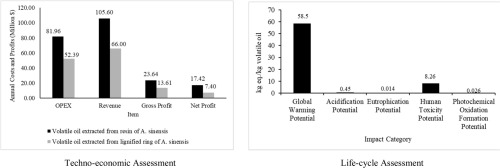Journal of CO2 Utilization ( IF 7.2 ) Pub Date : 2020-01-31 , DOI: 10.1016/j.jcou.2020.01.002 Yong Ling Gwee , Suzana Yusup , Raymond R. Tan , Chung Loong Yiin

|
Extracts of Aquilaria sinensis possess pharmacological activity that has been widely used in traditional medicines since ancient times. In this study, techno-economic assessment was conducted for extraction of volatile oil from abundant biomass (lignified ring) and resin of A. sinensis to evaluate their respective economic feasibility using supercritical carbon dioxide (SC-CO2) extraction in Malaysia. The assessment revealed that for a production capacity of 5280 kg/y volatile oil, the total capital investment (TCI) was $ 7.11 million from summation of fixed capital cost and working capital. In terms of operating expenditure (OPEX), the volatile oil extracted from resin and lignified ring of A. sinensis required $ 81.96 million and $ 52.39 million, respectively. The selling price of volatile oil from resin and lignified ring were estimated to be $ 0.025 million/kg and $ 0.0125 million/kg, respectively. Both volatile oil extracted from resin and lignified ring showed a positive net profit which indicated their profitability. In addition, a cradle-to-gate analysis of life-cycle assessment (LCA) was performed, whereby the extraction process contributed the highest impact towards the environment due to its high energy consumption. Nevertheless, this study estimated that the process might reduce the environmental impacts by approximately 90% when the technology readiness levels (TRLs) reach the level of 9–10. These findings are beneficial in providing preliminary insights in terms of economic and environmental aspects for volatile oil extraction using SC-CO2 technology.
中文翻译:

利用超临界二氧化碳从沉香中提取挥发油的技术经济和生命周期评估
沉香的提取物具有自古以来已广泛用于传统药物中的药理活性。在这项研究中,进行了技术经济评估,从马来西亚丰富的生物量(木质化环)和中华曲霉的树脂中提取挥发油,以评估其各自的经济可行性,使用超临界二氧化碳(SC-CO 2)提取。评估显示,对于5280千克/年挥发油的生产能力,固定资本成本和营运资本的总资本投资(TCI)为711万美元。从运营支出(OPEX)的角度出发,从中华按蚊的树脂和木质化环中提取的挥发油分别需要8196万美元和5239万美元。来自树脂和木质环的挥发油的售价分别估计为2.5万美元/ kg和14.25万美元/ kg。从树脂和木质环提取的挥发油均显示正的净利润,这表明它们的盈利能力。此外,还进行了生命周期评估(LCA)的从摇篮到大门的分析,由于其能耗高,提取过程对环境的影响最大。尽管如此,这项研究估计,当技术准备水平(TRL)达到9-10时,该过程可能会减少约90%的环境影响。2技术。











































 京公网安备 11010802027423号
京公网安备 11010802027423号